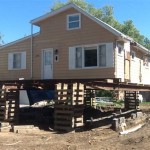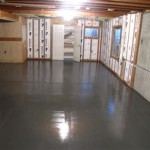Corner Basement Leaking Water From Ceiling: What Should I Do?
A leaking basement ceiling is a common and frustrating problem. It can indicate a more serious issue and lead to mold growth, structural damage, and other costly repairs if left unaddressed. The presence of water leaking from a specific corner of the basement ceiling can be particularly concerning, as it often points to a localized source of water intrusion. This article will explore some of the most probable causes of corner basement leaks, provide practical troubleshooting steps, and outline the necessary actions to take to resolve the issue.
Identify the Source of the Leak
The first step in addressing a corner basement leak is to pinpoint the source of the water intrusion. This can be accomplished through careful observation and investigation. Look for any visible signs of water damage, such as water stains, peeling paint, or dampness on the ceiling and walls. Additionally, check the surrounding area for potential entry points, including:
- Cracks in the foundation: Tiny cracks in the foundation walls can allow rainwater to seep into the basement.
- Improperly sealed windows and doors: Gaps around windows and doors can create pathways for water to enter the basement.
- Gutters and downspouts: If gutters and downspouts are clogged or damaged, they can overflow and direct water towards the foundation.
- Roofing issues: Leaks in the roof can cause water to travel down the roof frame and into the basement.
- Poorly sealed basement windows: Leaking windows can be a significant source of water intrusion in basements.
Once you have located the source of the leak, you can begin to address the problem.
Addressing the Leak
The approach to fixing a corner basement leak will vary depending on the source of the water intrusion. Here are some common solutions:
Cracks in the Foundation
Cracks in the foundation should be repaired with a water-resistant sealant. Epoxy-based sealants are particularly effective for this purpose. The crack must be cleaned thoroughly and allowed to dry completely before the sealant is applied. If the crack is significant, professional repairs may be required, involving underpinning or other structural reinforcement.
Improperly Sealed Windows and Doors
Gaps around windows and doors can be sealed using weatherstripping or caulk. Apply weatherstripping around the perimeter of the window or door frame, ensuring a tight seal. Caulk can be used to fill small gaps and cracks around the frame. It is important to use a high-quality, waterproof sealant to prevent moisture from penetrating the basement.
Gutters and Downspouts
Ensure that gutters are properly pitched and downspouts are extended away from the foundation. Regularly clean gutters and downspouts to prevent clogs and ensure proper water drainage. Debris buildup in gutters can impede water flow, leading to overflow and water intrusion into the basement.
Roofing Issues
If the leak is originating from the roof, a professional roofing contractor should be contacted to inspect and repair the roof. Damage to roof shingles, flashing, or other components can cause leaks that can infiltrate the basement.
Poorly Sealed Basement Windows
Similar to improperly sealed exterior doors and windows, basement windows can also be a source of water intrusion. Check for gaps around the window frame and use weatherstripping or caulk to seal them. Ensure that the windows are operating smoothly and that there are no cracks in the glass.
Preventing Future Leaks
After addressing the immediate leak, it is essential to take steps to prevent future water intrusions. This includes:
- Regular inspections: Conduct regular inspections of the basement, paying attention to areas that are prone to leaking, such as corners, around windows, and along the foundation walls.
- Proper drainage: Ensure that the surrounding landscape slopes away from the foundation to prevent water from pooling near the building.
- Maintaining gutters and downspouts: As previously mentioned, keeping gutters clean and downspouts unobstructed is essential to prevent water from overflowing and damaging the foundation.
- Addressing moisture issues: High humidity levels in the basement can exacerbate water damage. Install a dehumidifier to control moisture levels and prevent condensation.
By taking these proactive measures, you can minimize the risk of recurring leaks and protect your basement from water damage.

Finding The Source Of A Basement Water Problem Energy Vanguard

My Ceiling Is Wet And I Can T Find The Water Leak A J Restoration

Finding The Source Of A Basement Water Problem Energy Vanguard

Water Stain On Ceiling What It Means To Do Next

Water Damage In Your Ceiling Isn T Always Easy To Spot Servpro

How To Fix A Leaking Basement From The Inside Tips For Homeowners

Here S What Plumbers Say To Do About A Water Stain On The Ceiling

Water Damage In Your Ceiling Isn T Always Easy To Spot Servpro

Ceiling Water Damage Everything You Need To Handle It Correctly 1 Tom Plumber

Water Stain On Ceiling What It Means To Do Next
Related Posts







